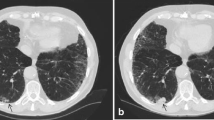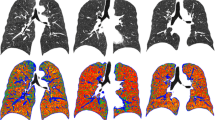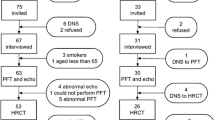Abstract
We assessed with computed tomography (CT) densitometry the prevalence of emphysema in 266 (175 men and 91 women; mean age 64 ± 4 years) smokers and former smokers enrolled in the ITALUNG trial of lung cancer screening with low-dose thin-slice CT. Whole-lung volume and the relative area at −950 Hounsfield units (RA950) and mean lung attenuation (MLA) in 1 of every 10 slices (mean, 24 slices per subject) were measured. Lung volume, MLA and RA950 significantly correlated each other and with age. Average RA950 >6.8% qualifying for emphysema was present in 71 (26.6%) of 266 subjects, with a higher prevalence in men than in women (30.3% vs 19.8%; p = 0.003). Only in smokers was a weak (r = 0.18; p = 0.05) correlation between RA950 and packs/year observed. In multiple regression analysis, the variability of RA950 (R2 = 0.24) or MLA (R2 = 0.34) was significantly, but weakly explained by age, lung volume and packs/year. Other factors besides smoking may also have a significant role in the etiopathogenesis of pulmonary emphysema.



Similar content being viewed by others
References
American Thoracic Society (1995) Standards for the diagnosis and care of patients with chronic obstructive pulmonary disease. Am J Respir Crit Care Med 152:S77–S121
Dalal PU, Hansell DM (2006) High-resolution computed tomography of the lungs: the borderlands of normality. Eur Radiol 16:771–780
Remy-Jardin M, Edme JL, Boulenguez C et al (2002) Longitudinal follow-up study of smoker’s lung with thin section CT in correlation with pulmonary function tests. Radiology 222:261–270
Omori H, Nakashima R, Otsuka N et al (2006) Emphysema detected by lung cancer screening with low-dose spiral CT: prevalence, and correlation with smoking habits and pulmonary function in Japanese male subjects. Respirology 11:205–210
Desai SR, Hansell DM, Walker A et al (2007) Quantification of emphysema: a composite physiologic index derived from CT estimation of disease extent. Eur Radiol 17:911–918
Bakker HE, Stolk J, Putter H et al (2005) Variability in densitometric assessment of pulmonary emphysema with computed tomography. Invest Radiol 40:777–783
Müller NL, Staples CA, Miller RR et al (1988) “Density mask”. An objective method to quantitate emphysema using computed tomography. Chest 99:782–787
Kinsella M, Müller NL, Abboud RT (1990) Quantitation of emphysema by computed tomography using a “density mask” program and correlation with pulmonary function tests. Chest 97:315–321
Gould GA, MacNee W, McLean A et al (1988) CT measurements of lung density in life can quantitate distal airspace enalrgement: an essential defining feature of human emphysema. Am Rev Respir Dis 137:380–392
Bankier AA, De Maertelaer V, Keyzer C et al (1999) Pulmonary emphysema: subjective visual grading versus objective quantification with macroscopic morphometry and thin-section CT densitometry. Radiology 211:851–858
Kauzcor HU, Hast J, Heussel CP et al (2002) CT attenuation of paired HRCT scans obtained at full inspiratory/expiratory position: comparison with pulmonary function tests. Eur Radiol 12:2757–2763
Coxson HO (2007) Computed tomography and monitoring of emphysema. Eur Respir J 29:1075–1077
Ley-Zaporozhan J, Ley S, Kauzcor HU (2008) Morphological and functional imaging in COPD with CT and MRI: present and future. Eur Radiol 18:510–521
Wang Q, Takashima S, Wang JC et al (2001) Prevalence of emphysema in individuals who underwent screening CT for lung cancer in Nagano Prefecture of Japan. Respiration 68:352–356
Nawa T, Nakagawa T, Kusano S et al (2002) Prevalence of emphysematous changes as shown by low-dose spiral CT screening images in 6144 healthy subjects. Nihon Kokyuki Gakkai Zasshi 40:468–472
de Torres JP, Bastarrika G, Wisnivesky JP et al (2007) Assessing the relationship between lung cancer risk and emphysema detected on low-dose CT of the chest. Chest 132:1932–1938
Dransfield MT, Washko GR, Foreman MG et al (2007) Gender differences in the severity of CT emphysema in COPD. Chest 132:464–470
Picozzi G, Paci E, Lopez Pegna A et al (2005) Screening of lung cancer with low dose spiral CT: results of a three year pilot study and design of the randomised controlled trial “Italung-CT”. Radiol Med (Turin) 109:17–26
Aberle DR, Gamsu G, Henschke CI et al (2001) A consensus statement of the Society of Thoracic Radiology: screening for lung cancer with helical computed tomography. J Thoracic Imaging 16:65–68
Gevenois PA, de Maertelaer V, De Vuyst P et al (1995) Comparison of computed density and macroscopic morphometry in pulmonary empyhsema. Am J Resp Crit Care Med 152:653–657
Gevenois PA, De Vuyst P, de Maertelaer V et al (1996) Comparison of computed density and microscopic morphometry in pulmonary emphysema. Am J Resp Crit Care Med 154:187–192
Madani A, Zanen J, de Maertelaer V et al (2006) Pulmonary emphysema: objective quantification at multi-detector row CT: comparison with macroscopic and microscopic morphometry. Radiology 238:1036–1043
Orlandi I, Moroni C, Camiciottoli G et al (2005) Chronic obstructive pulmonary disease: thin-section CT measurement of airway wall thickness and lung attenuation. Radiology 234:604–610
Gevenois PA, Scillia P, de Maertelaer V et al (1996) The effects of age, sex, lung size, and hyperinflation on CT lung densitometry. AJR Am J Roentgenol 167:1169–1173
Diciotti S, Petrolo L, Falchini M et al (2004) Neural network system for lung nodule detection in spiral CT images: preliminary results. In Book of Abstracts of the Mediterranean Conference on Medical and Biological Engineering, Ischia, Italy July 31-August 5
Hu S, Hoffman EA, Reinhardt JM (2001) Automatic lung segmentation for accurate quantitation of volumetric X-ray CT images. IEEE Trans Med Imaging 20:490–498
Snider G, Kleinerman J, Thurlbeck WM et al (1985) The definition of emphysema: report of a National Heart, Lung and Blood Institute, Division of Lung Disease workshop. Am Rev Respir Dis 132:182–185
Mannino DM (2002) COPD: epidemiology, prevalence, morbidity and mortality, and disease heterogeneity. Chest 121:121S–126S
Madani A, Keyzer C, Gevenois PA (2001) Quantitative computed tomography assessment of lung structure and function in pulmonary emphysema. Eur Respir J 18:720–730
Pauwels RA, Buist AS, Ma P et al (2001) Global strategy for the diagnosis, management and prevention of chronic obstructive pulmonary disease: National Heart, Lung and Blood Institute and World Health Organization Global Initiative for Chronic Obstructive Lung Disease (GOLD); executive summary. Respir Care 46:798–825
Lundbäck B, Lindberg A, Lindström M et al (2003) Not 15 but 50% of smokers develop COPD? Report from the Obstructive Lung Disease in Northern Sweden Studies. Respir Med 97:115–122
Siafakas NM, Tzortzaki EG (2002) Few smokers develop COPD. Why ? Respir Med 96:615–624
Boedeker KL, McNitt-Gray MF, Rogers SR et al (2004) Emphysema: effect of reconstruction algorithm on CT imaging measures. Radiology 232:295–301
Kemerink GJ, Kruize HH, Lamers RSJ et al (1996) Density resolution in quantitative computed tomography of foam and lung. Med Phys 23:1697–1708
Vikgren J, Friman O, Borga M et al (2005) Detection of mild emphysema by computed tomography density measurements. Acta Radiol 46:237–245
Gierada DS, Pilgram TK, Whiting BR et al (2007) Comparison of standard- and low-radiation-dose CT for quantification of emphysema. AJR Am J Roentgenol 188:42–47
Madani A, de Maertelaer V, Zanen J et al (2007) Pulmonary emphysema: radiation dose and section thickness at multidetector CT quantification: comparison with macroscopic and microscopic morphometry. Radiology 243:250–257
Zaporozhan J, Ley S, Weinheimer O et al (2006) Multi-detector CT of the chest: influence of dose onto quantitative evaluation of severe emphysema: a simulation study. J Comput Assist Tomogr 30:460–468
Clark KD, Wardrobe-Wong N, Elliot JJ et al (2001) Patterns of lung disease in a “normal” smoking population: are emphysema and airflow obstruction found together? Chest 120:743–747
Spaggiari E, Zompatori M, Verduri A et al (2005) Early smoking-induced lung lesions in asymptomatic subjects. Correlations between high resolution dynamic CT and pulmonary function testing. Radiol Med (Turin) 109:27–39
Gillooly M, Lamb D (1993) Microscopic emphysema in relation to age and smoking habit. Thorax 48:491–495
Tylén U, Boijsen M, Ekberg-Jansson A et al (2000) Emphysematous lesions and lung function in healthy smokers 60 years of age. Respir Med 94:38–43
Sashidhar K, Gulati M, Gupta D et al (2002) Emphysema in heavy smokers with normal chest radiography. Detection and quantification by HRCT. Acta Radiol 43:60–65
Altman DG, Royston P (2006) The cost of dichotomising continuous variables. BMJ 332:1080
Gillooly M, Lamb D (1993) Airspace size in lungs of lifelong non-smokers: effect of age and sex. Thorax 48:39–43
Brozek J (1960) Age differences in residual lung volume and vital capacity of normal individuals. J Gerontol 15:155–160
Silverman EK, Chapman HA, Drazen JM et al (1998) Genetic epidemiology of severe, early-onset chronic obstructive pulmonary disease. Risk to relatives for airflow obstruction and chronic bronchitis. Am J Respir Crit Care Med 157:1770–1778
McCloskey SC, Patel BD, Hinchliffe SJ et al (2001) Siblings of patients with severe chronic obstructive pulmonary disease have a significant risk of airflow obstruction. Am J Respir Crit Care Med 164:1419–1424
Further Reading
Mishima M, Itoh H, Sakai H et al (1999) Optimized scanning conditions of high resolution CT in the follow-up of pulmonary emphysema. J Comput Assist Tomogr 23:380–384
American Thoracic Society (1995) Standardization of spirometry, 1994 update. Am J Respir Crit Care Med 152:1107–1136
American Thoracic Society (1995) Single-breath carbon monoxide diffusing capacity (transfer factor): recommendations for a standard technique. Am J Respir Crit Care Med 152:2185–2198
Author information
Authors and Affiliations
Corresponding author
Electronic supplementary material
Below is the link to the electronic supplementary material.
Table 1
Spearman rank correlation between averaged (three levels) RA at −930, −940, −950, −960 and −970 HU measured from low dose thin-section spiral acquisitions and RA at −950 HU measured from standard dose thin-section sequential acquisitions (PDF 20.3 KB)
Fig. 4
Mean values of FRC and DLCO (%of predicted ± SD) in subjects without emphysema (black columns) and with emphysema (white columns). ***p < 0.001 (PDF 26.3 KB)
Appendices
Appendix 1
To establish which RA using low-dose spiral CT better correlates with RA950 in the standard-dose sequential CT, we obtained in 25 consecutive subjects (14 men, 11 women, mean age 60.8 years after further informed consent) of the 266 undergoing lung cancer screening supplemental 1-mm-thick slices with sequential acquisition at standard dose (140 kVp and 200 mAs) and with a sharp reconstruction filter (B60). According to widely accepted protocols [4, 23, 49] and to contain the supplemental radiation dose, only three thin slices of sequential CT at standard dose were obtained at predetermined levels: at the carina and 5 cm below and above the carina. Using the Pulmo software, the operator selected in the 25 subjects the three spiral slices corresponding to the three levels at which the sequential slices had been acquired. In the spiral CT mode, the RA at −930 HU (RA930), −940 HU( RA940), −950 HU (RA950), −960 HU (RA960) and −970 HU (RA970) was calculated for each slice and averaged, whereas on the sequential CT images only the single slice and average RA950 values were calculated. The Spearman rank correlation test (Supplementary Table 1) showed that the average RA950 from low-dose spiral acquisitions was the RA value more closely correlated (R = 0.90) to average RA950 from standard-dose sequential acquisitions.
Appendix 2
Pulmonary function tests (PFT) are not part of the protocol of the ITALUNG trial. To obtain an independent confirmation of the diagnosis of emphysema, 25 of the 71 subjects with emphysema and 25 of the 195 subjects without emphysema at lung densitometry matched for gender, age and packs/year underwent PFT. Functional residual capacity (FRC) and single-breath lung diffusion capacity for carbon monoxide (DLCO) were measured using a constant volume body plethysmograph equipped with a multi-gas analyzer (V6200 Autobox DL, Sensor Medics, Yorba Linda, CA), according to American Thoracic Society standards and expressed as percent of predicted value [50, 51]. Subjects with emphysema showed significantly lower DLco and higher FRC values as compared to subjects without emphysema (Fig. 4, supplementary material).
Rights and permissions
About this article
Cite this article
Camiciottoli, G., Cavigli, E., Grassi, L. et al. Prevalence and correlates of pulmonary emphysema in smokers and former smokers. A densitometric study of participants in the ITALUNG trial. Eur Radiol 19, 58–66 (2009). https://doi.org/10.1007/s00330-008-1131-6
Received:
Revised:
Accepted:
Published:
Issue Date:
DOI: https://doi.org/10.1007/s00330-008-1131-6




